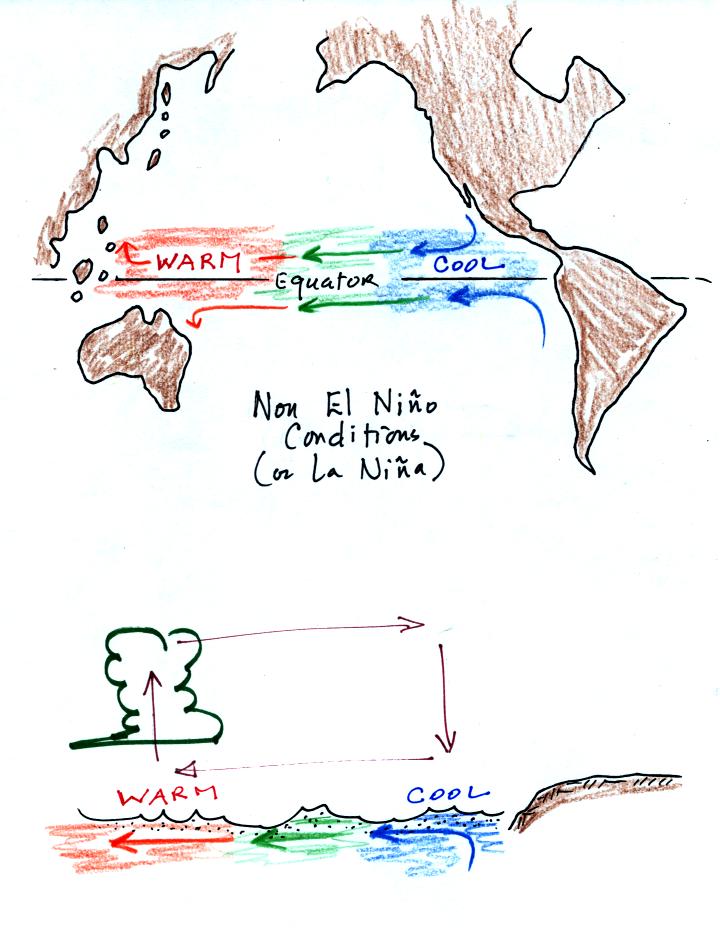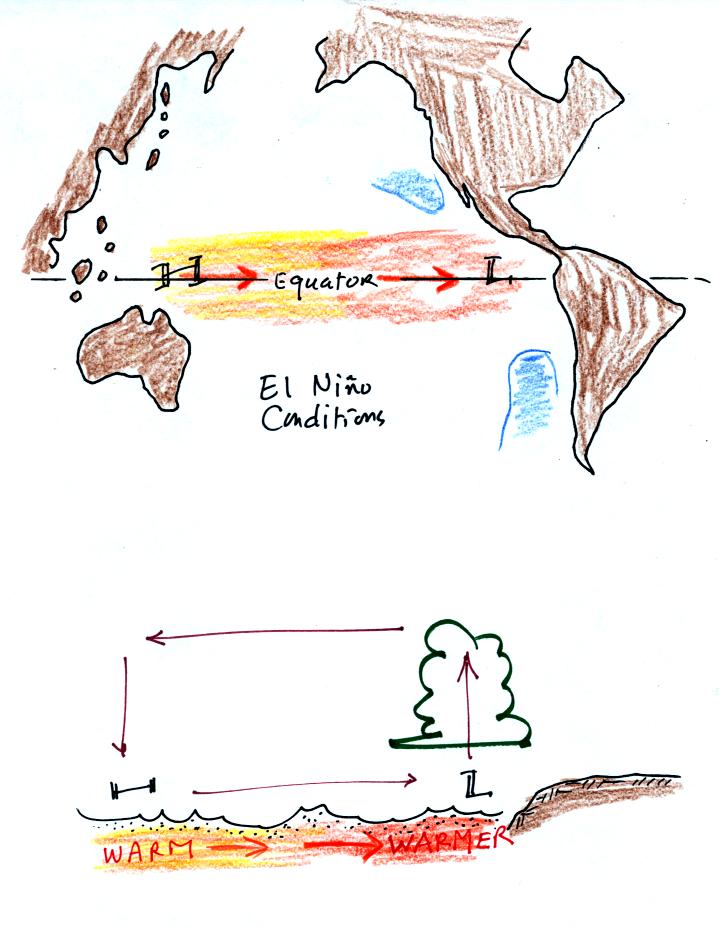Winds
spin CCW around H pressure in the S. Hemisphere. So you'd find a
cold northward flowing current along the west coast of S.
America. Note the names of the high pressure centers in the N.
Hemisphere: the Pacific High and the Bermuda High.
Now a quick review. The temperature differences shown below could
create a thermal circulation. What direction would it blow?
It's easy to figure out if you remember that warm air
rises. Draw
an upward pointing arrow above the warm part of the picture
and then complete the loop.
Now with what you know something about ocean currents off the W
Coasts of N and S America & thermal circulations, you're in a
excellent position to understand the El Nino phenomena (and yes I'm
repeating something that was embedded in last Monday's notes but wasn't
discussed in class)
Here's the normal situation in the
tropical Pacific Ocean.
Cold ocean currents
along the west coasts of N. America and S.
American normally converge at the equator and begin to flow westward
(see top view above). As the water travels westward it
warms. Some of the warmest sea surface waters on earth are
normally found
in the western Tropical Pacific. A temperature gradient becomes
established between the W. and E. ends of the tropical Pacific. The
crossectional view above shows the normal temperature and circulation
pattern found in the equatorial Pacific Ocean. You would
find surface high pressure in the east and low pressure in the
west. Note that the wind circulation pattern is the same as the
simple thermal circulation we studied above. You'd expect rainy
weather in the west and drier weather on the eastern side of the
Pacific.
Every few years El Nino conditions
occur and the cold
currents don't
make it to the
Equator. Warm water is carried from the western Pacific to the
eastern Pacific
Now surface high
pressure is found in the west and surface low
pressure and rising air is found in the E. Pacific (the reversal in the
surface pressure pattern is referred to as the southern
oscillation). Indonesia and Australia often experience drought
conditions during El Nino events. In the desert SW we expect
slightly wetter than normal conditions (perhaps 20% wetter than
normal). Wetter conditions are also found in California and in
the SE US.
This past winter we have been under the influence of La Nina.
That's when the cold water normally found in the easter Pacific is
colder than normal. It usually means dry winter weather for
Arizona. That has certainly been the case this year, we've only
had about 20% of our normal rainfall.

The close proximity of the Pacific high, with its sinking air motions,
is what gives California, Oregon, and Washington dry summers.
In the winter the subtropical high moves south of 30 N latitude.
Winds to the north of the high blow from the west. Air
originating over the Pacific Ocean loses much of its moisture as it
crosses mountains in California (remember the rain shadow
effect). The air is pretty dry by the time it reaches
Arizona. Significant winter rains occur in Arizona when storms
systems are able to draw moist subtropical air from the southwest
Pacific ocean into
Arizona.
We're next going to spend a couple of lectures on
thunderstorms. Here's a little bit of an introduction
Thunderstorms come in different sizes and levels of
severity. We will mostly be concerned with ordinary
single-cell thunderstorms
(also referred to as air mass thunderstorms). Most summer
thunderstorms in Tucson are this type. An air mass
thunderstorm has a vertical updraft. A cell is just a
thunderstorm "unit."
Tilted updrafts are found in severe and supercell thunderstorms.
As we shall see this allows those storms to get bigger, stronger, and
last longer. Supercell thunderstorms have a complex internal
structure; we'll watch a short
video at some point that shows a computer simulation of the complex air
motions inside a supercell thunderstorm.
The
following somewhat tedious material was intended to
prepare you to better appreciate a time lapse video movie
of a thunderstorm developing over the Catalina mountains. I don't
expect you to remember all of the details given below. The
figures below are more carefully drawn versions of what was done in
class.

Refer back and forth between the lettered points in
the
figure
above and the commentary below.
The numbers in Column A
show the temperature of the air in the atmosphere at various altitudes
above the ground (note the altitude scale on the right edge of the
figure). On this particular day the air temperature was
decreasing at a rate of 8 C per kilometer. This rate of decrease
is referred to as the environmental lapse rate (lapse rate just means
rate of decrease with altitude). Temperature could
decrease more quickly than shown here or less rapidly.
Temperature in the atmosphere can even increase with increasing
altitude
(a temperature inversion).
At Point B, some of
the surface air is put into an imaginary container, a parcel.
Then a meterological process of some kind lifts the air to 1 km
altitude (in Arizona in the summer, sunlight heats the ground and air
in contact with the ground, the warm air becomes bouyant - that's
called free convection). The
rising air will expand and cool as it is
rising. Unsaturated (RH is less than 100%) air cools at a rate of
10 C per
kilometer. So the 15 C surface air will have a temperature of 5 C
once it arrives at 1 km altitude.
"Mother Nature" lifts the parcel to 1 km and "then lets go." At Point C note that
the air inside the parcel is slightly colder than the air outside (5 C
inside versus 7 C outside). The air inside the parcel will be
denser than the air outside and the parcel will sink back
to the
ground.
By 10:30 am the parcel is being lifted to 2 km as shown at Point D. It is still
cooling 10 C for every kilometer of altitude gain. At 2 km, at Point E the
air
has
cooled
to
its dew point temperature and a cloud has
formed. Notice at Point
F, the air in the parcel or in the cloud (-5 C) is still colder
and denser than the surrounding air (-1 C), so the air will sink back
to the ground and the cloud will disappear. Still no thunderstorm
at this point.
At noon, the air is lifted to 3
km. Because the
air
became saturated at 2 km, it will cool at a different rate
between 2 and
3 km altitude. It cools at a rate of 6 C/km instead of 10
C/km. The saturated air cools more slowly because release of
latent heat
during condensation offsets some of the cooling due to
expansion. The air that arrives at 3km, Point H, is again still
colder than the
surrounding air and will sink back down to the surface.
By 1:30 pm the air is getting high enough that it has become
neutrally
bouyant, it has the same temperature and density as the air around it
(-17 C inside and -17 C outside). This is called the level of
free convection, Point J in the figure.
If you can, somehow or another, lift air above the level of
free
convection it will find itself warmer and less dense than the
surrounding air as shown at Point K and will float upward to the top of
the troposphere on its own. This is really the
beginning of a thunderstorm. The thunderstorm will grow
upward
until it reaches very stable air at the bottom of the stratosphere.
This was
followed by a time lapse video tape of
actual thunderstorm formation and growth.











